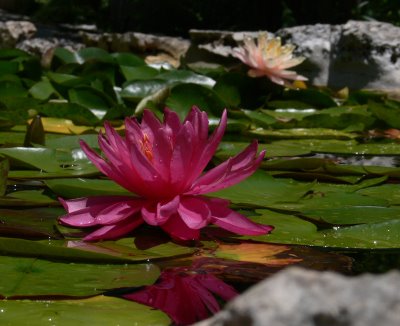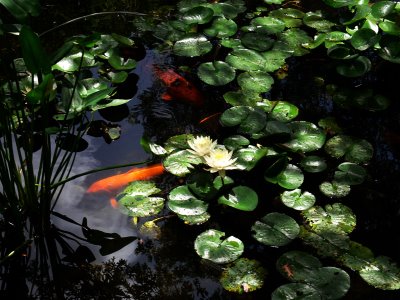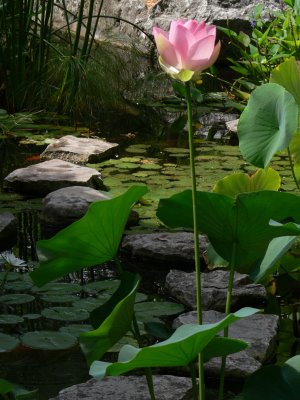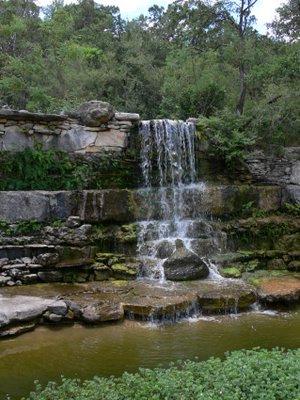When the elder Taniguchi retired from farming in 1967, he moved to Austin to be with his son and he began building, on an unused hillside in Zilker park, an "Oriental garden" with pools and streams and a waterfall and bamboo and water lilies. The word Oriental had not fallen into disfavor yet. He built a bamboo "tea house" which is still a nice place to sit on a hot day. He did much of the work himself. Actually, he probably did most of it--he had one assistant. There's a little wooden footbridge. A waterfall. Stone stairs. Nice stonework. Koi in the ponds, enormous ones. Water lilies in many colors. Lotsa bamboo, of many different species and horticultural varieties. On some days you see Asian people, who may possibly be Japanese tourists, taking photos with much better cameras than mine.
The city has built a formal rose garden and several thematic gardens next to the Japanese Garden, all of which together are now called Zilker Gardens. Like everything to do with civilization nowadays, the gardens are underfunded, so portions are poorly maintained. I don't mind that. It wouldn't be Austin if it were well organized and had all the plants properly labeled and cost $6.00 to get in. There is perpetual talk of making it a "real" botanical garden, with admission fees and with all the quirk removed.
When dinosaur tracks were discovered in the hillside below the garden, a "prehistoric garden" was built around the trackway, with some cycads and stuff and a big 13 foot bronze Onithomimus dinosaur in the middle of a pond. An Ornithomimus made the tracks. I have a photo of the statue below.
As you enter the gardens, a glass covered bulletin board next to the parking lot announces 10 or 15 points of garden etiquette, including not picking the flowers, not eating your lunch on the grounds (that one is a mystery to me), keeping your dog on a five foot leash and out of the ponds, and so forth. Posted more prominently, above the sheet of etiquette, is a medical advisory on heat stroke and heat exhaustion, which enumerates, as bullet points, even more warnings than the etiquette sheet. Small print. Alarming to read. Cannot be encouraging to summertime visitors from Tokyo, or anyone from a cool climate.
Friday morning I ran into, or was run past by, occasional loose swarms of children wearing matching t-shirts being steered through the garden by unenthusiastic young people of camp-counselor age desperate to hold the attention of their charges using a strategy, doomed from the start, of pitching their voice at a register of unconvincing excitement, announcing, as one example I remember, the discovery of a turtle among the lotuses.
The children were not interested in lotuses, though were somewhat interested in turtles, only momentarily, but were mostly interested in running off in several directions while the vocal register of the leadership slipped in the direction of ineffectual shouts disappearing into the wind. Get back here. Right...now. Eventually the pod of children would reassemble, through some kind of social gravity, not the will of the leadership, and they would move on to the next point of interest, the ponds full of enormous koi, which did indeed seem to engage everyone, or so I deduced from shouts beyond the bamboos.
But most of the visitors--and there weren't many, really--were small families, usually mothers with one or two children. One lady admonished her son, who had just pushed his sister, to behave better, "or people will think you don't have any brains." It was like she was speaking these words to be heard by those hypothetical "people," causing me to swirl momentarily into the whirlpool of someone else's family drama, I being the only person around. But they went on their way and then I was alone again with the dragonflies for a while.
It's a nice place, though as I have said, it doesn't know quite what kind of garden it wants to be, and has weird stuff no serious botanical garden would put on display, like a fake old-timey blacksmith shop with a wooden corral with rusting mule-drawn farm equipment out back, and an enormous iron cauldron four feet across and two feet deep, in front. It was unclear what the tub was used for. A plaque speculated that it may have been involved in making gunpowder during Confederate times.
Then there are two transplanted log cabins. I don't think anyone really knows why they are there. One of them is the old Esperanza School, a single dank room moved from its original location. Esperanza is a surname, but also means "hope" in Spanish, which is the exact opposite of the message this structure conveys. It has a large millstone as a steppingstone before the doorway. The other cabin was built and occupied by Swedish settlers on the east side of town, before being moved here. Austin had a lot of Swedish immigrants in the 19th century. The most interesting thing about the Swedish cabin was the sign on the wall which declared the edifice was "an example of free enterprise that built America." As with the no-lunch rule, I was puzzled by that.
I took a good many dragonfly photos--the lotus ponds hosted an aerial circus of odonates--but I will save them for later.
Pictures of the garden
The dinosaur pond, with 13 ft. Ornithomimus

Lotuses

Bamboo grove

Big goldfish and waterlilies

Pink waterlily

Untended roses

Dinosaur garden waterfall

Click any photo to enlarge
No comments:
Post a Comment